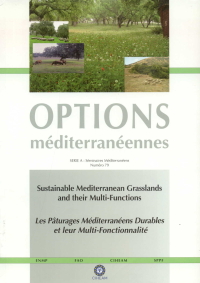| Article précédent | p. 137-146 | Article suivant |
Perennial grasses in rainfed Mediterranean farming systems: current and potential role
Past and recent development of perennial grasses is reviewed across environments and under the main types of farming systems. Few adapted cultivars (cvs) are registered and only seeds from French and Australian cvs are available. As a result, there is insufficient use of these grasses. In future developments, a perennial grass-legume mixture is the best model to optimise both livestock nutrition and environmental impacts. In Europe both roles contribute to farm income either via the market or public subsidies. Adapted cvs exist for climates with annual rainfall >500 mm and accumulated water deficit from May to September (late spring to end of summer) <700 mm. The role that perennial grasses can play in maintaining landscape services has also lead to the development of new cvs and associated seed production. Future research programs should: (i) define suitable mixtures and management of pastures; and (ii) further improve drought tolerance. There needs to be further development of the summer dormancy trait exhibited in cocksfoot, tall fescue and phalaris ecotypes from North Africa and desiccation tolerance sourced from the wild species Poa bulbosa. It is proposed to strengthen research coordination in the Mediterranean and to structure links with Australia where research and the seed industry actively develop Mediterranean germplasm in similar climates.
Cette revue présente un bilan du développement récent des graminées pérennes dans les régions méditerranéennes sèches, par type de système agraire. Peu de cultivars (cvs) sont inscrits et seuls ceux inscrits en France et en Australie ont des semences commercialisées. Ils ne sont significativement utilisés qu'en zones sub-tempérées. A l'avenir, les mélanges graminée-légumineuse à deux ou plusieurs composants s'imposent pour optimiser la production animale et les bénéfices environnementaux, tous deux contribuant au revenu des exploitations. Les cvs existants sont adaptés à une pluviométrie annuelle > 500 mm avec déficit climatique cumulé mai-septembre < 700 mm. L'utilisation croissante des pérennes fourragères en couverture dans des systèmes culturaux intensifs pour améliorer leur bilan environnemental va stimuler la sélection de nouveaux cvs pour cet usage. Ces variétés doivent être plus facilement accessibles. Les objectifs prioritaires de la recherche sont l'analyse du comportement en association et la tolérance à la sécheresse, en exploitant la dormance estivale rencontrée chez certains écotypes de dactyle du Maroc, ainsi que la tolérance à la déshydratation d'espèces comme Poa bulbosa. Il est recommandé de renforcer la coordination au sein du Bassin méditerranéen et de structurer les relations avec l'Australie, où la recherche et l'industrie semencière travaillent le matériel végétal méditerranéen sous les mêmes climats.
- [ Afficher ]
- [ Télécharger ]
- [ Exporter la citation ]
Vous pouvez télécharger la citation au format :
- [ Imprimer ]
-
Mots-clés
COUVERTURE VEGETALE, CULTURE EN MELANGE, CULTURE INTERCALAIRE, ECOSYSTEME, GRAMINEE FOURRAGERE, LEGUMINEUSE FOURRAGERE, PRAIRIE, REGION MEDITERRANEENNE, RESISTANCE A LA SECHERESSECiter cet article
Lelièvre F., Norton M.R., Volaire F. Perennial grasses in rainfed Mediterranean farming systems: current and potential role. In : Porqueddu C. (ed.), Tavares de Sousa M.M. (ed.). Sustainable Mediterranean grasslands and their multi-functions . Zaragoza : CIHEAM / FAO / ENMP / SPPF, 2008. p. 137-146. (Options Méditerranéennes : Série A. Séminaires Méditerranéens; n. 79). 12. Meeting of the Sub-Network on Mediterranean Forage Resources of the FAO-CIHEAM Inter-regional Cooperative Research and Development Network on Pastures and Fodder Crop, 2008/04/09-12, Elvas (Portugal). http://om.ciheam.org/om/pdf/a79/00800635.pdf



